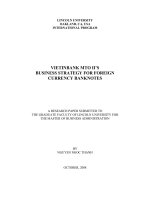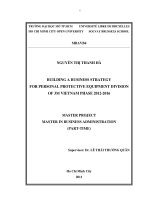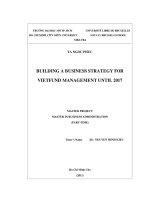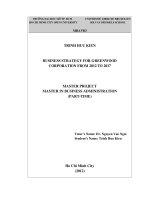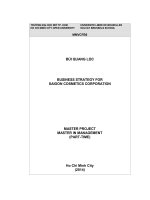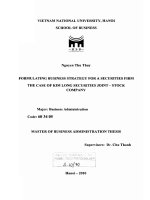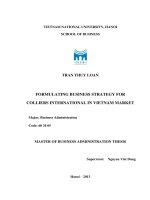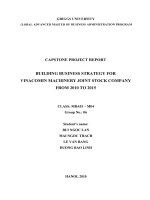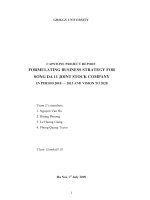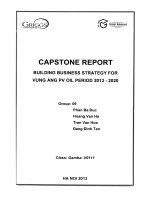Formulating business strategy for Agribank Ninh Binh branch period from 2013 to 2018
Bạn đang xem bản rút gọn của tài liệu. Xem và tải ngay bản đầy đủ của tài liệu tại đây (1.86 MB, 80 trang )
1
FORMULATING BUSINESS STRATEGY
FOR AGRIBANK NINH BINH BRANCH
PERIOD FROM 2013 TO 2018
CAPSTONE PROJECT REPORT
H A N O I 2 0 1 2
Group No.08:
Nguyen Thi Minh Nguyet
Dang Le Ngoc
Nguyen Thanh Tam
Dong Anh Tuan
Le Thi Hop
Class: GaMBA.M0111
2
GLOBAL ADVANCED MASTER OF BUSINESS ADMINISTRATION PROGRAM
CAPSTONE PROJECT REPORT
FORMULATING BUSINESS STRATEGY
FOR AGRIBANK NINH BINH BRANCH
PERIOD FROM 2013 TO 2018
Group 8
Nguyen Thi Minh Nguyet
Dang Le Ngoc
Nguyen Thanh Tam
Dong Anh Tuan
Le Thi Hop
Class: GaMBA.M0111
HANOI 2012
3
4
ACKNOWLEDGEMENT
We, members of Group 8 of GaMBA.M0111, would like to extend our deep
gratitude to the Center for Educational Technology & Career Development
(ETC), the Global Advanced Master of Business Administration (GaMBA) and
the Griggs University for your GaMBA Program. The courses gave us the most
advanced business management knowledge, improved our skills, and
strengthen our ability for future career development.
We also would like to express our sincere thanks to all the lecturers who
provided us with thorough lessons, valuable information and useful experience
through the courses, and Capstone Committee Members who gave us great
advice, recommendations and suggestions for us to complete our Capstone
Project.
We hereby acknowledge that our Capstone Project has been performed with
our best efforts in doing research, analysis and assessment. We hope our work
will be appreciated and recognized accordingly.
Yours Faithfully,
Group 8 - GaMBA.M0111
5
Table of Contents
LIST OF ABBREVIATIONS 9
LIST OF TABLES 10
LIST OF FIGURES 11
INTRODUCTION 12
CHAPTER 1 THEORETICAL BACKGROUND ON FORMULATING
BUSINESS STRATEGY FOR ENTERPRISES 15
1.1. Overview of Strategic Management 15
1.1.1. Definitions on Strategic Management 15
1.1.2. Stages of Strategic Management 15
1.1.3. Strategic Management Model 16
1.2. Strategy Formulation 17
1.2.1. Business Vision and Mission 17
1.2.2. External Environment Assessment 17
1.2.2.1. External Environment (PEST Analysis) 18
1.2.2.2. Competitive Analysis (Porter’s Five-Force Model) 19
1.2.3. Internal Environment Assessment 21
1.2.4. Strategies in Actions 22
1.2.4.1. Integration Strategies 22
1.2.4.2. Intensive Strategies 22
1.2.4.3. Diversification Strategies 23
1.2.4.4. Defensive Strategies 23
1.3. Strategy Analysis and Choice 23
1.3.1. Stage 1: The Input Stage 23
6
1.3.1.1. External Factor Evaluation (EFE) Matrix 23
1.3.1.2. Competitive Profile Matrix (CPM) 24
1.3.1.3. Internal Factor Evaluation (IFE) Matrix 24
1.3.2. Stage 2: The Matching Stage 24
1.3.2.1. Strengths-Weaknesses-Opportunities-Threats (SWOT) Matrix . 24
1.3.2.2. Strategic Position and Action Evaluation (SPACE) Matrix 25
1.3.3. Stage 3: Decision Stage 27
1.3.3.1. The Quantitative Strategic Planning Matrix (QSPM) 27
1.3.3.2. Strategy implementation 28
CHAPTER 2 ANALYSIS ON REAL BUSINESS SITUATION OF
AGRIBANK NINH BINH 30
2.1. Overview of Agribank Ninh Binh 30
2.1.1. Foundation and Development 30
2.1.1.1. Agribank Vietnam 30
2.1.1.2. Agribank Ninh Binh 30
2.1.2. Organizational Structure 31
2.1.3. Scope of Business, Services and Markets 31
2.1.4. Results of Business Operation 32
2.2. Business Environment Analysis 33
2.2.1. External Factors Assessment 33
2.2.1.1. Macro Environment (PEST Model) 33
2.2.1.2. Industrial Environment (M. Porter Model) 37
2.2.1.3. External Factors Evaluation (EFE) Matrix 40
2.2.1.4. Competitive Profile Matrix (CPM) 42
2.2.2. Internal Factors Assessment 47
2.2.2.1. Business Operation 47
2.2.2.2. Financial Resource 50
7
2.2.2.3. Human Resource and Organization 53
2.2.2.4. Marketing and Sales 54
2.2.2.5. Research and Development 54
2.2.2.6. Internal Factors Evaluation (IFE) Matrix 54
2.2.3. Defining Sustainable Competitive Advantages 56
2.3. Necessity to Formulate Business Strategies for Period 2013~2018 . 57
CHAPTER 3 FORMULATING BUSINESS STRATEGIES AND
PLANNING IMPLEMENTATION SOLUTIONS FOR AGRIBANK NINH
BINH PERIOD FROM 2013 TO 2018 58
3.1. Development Orientation 58
3.1.1. Vision, Mission and Core Values 58
3.1.2. Strategic Orientation by 2018 59
3.1.3. Business Targets 59
3.1.3.1. General Targets 59
3.1.3.2. Specific Targets up to 2018 60
3.2. Matrixes and Business Strategy Selection 60
3.2.1. SWOT Matrix Analysis 60
3.2.2. SPACE Matrix Analysis 64
3.3. Strategy Decision 65
3.3.1. QSPM Analysis 65
3.3.2. Strategic Solutions 68
3.3.2.1. Marketing Strategic Solutions 68
3.3.2.2. Human Resource Strategic Solutions 70
3.3.2.3. Risk Management Strategic Solutions 72
3.3.2.4. Financial Strategic Solutions 73
3.3.2.5. Other Strategic Solutions 73
8
3.4. Strategic Implementation 74
3.4.1. Business Expansion Plan 74
3.4.2. Organizational Structure Completion 75
3.4.3. Strategic Implementation Conditions 75
3.4.4. Implementation Roadmap 76
CONCLUSION 78
REFERENCES 80
9
LIST OF ABBREVIATIONS
GDP
Gross Domestic Product
WTO
World Trade Organization
USA
United States of America
Agribank
Vietnam Bank for Agriculture and Rural Development
Vietinbank
Vietnam Joint Stock Commercial Bank for Industry and Trade
BIDV
Vietnam Bank for Investment and Development
EFE
External Factor Evaluation
CPM
Competitive Profile Matrix
IFE
Internal Factor Evaluation
SWOT
Strengths-Weaknesses-Opportunities-Threats
SPACE
Strategic Position and Action Evaluation
QSPM
Quantitative Strategic Planning Matrix
AS
Attractiveness Scores
TAS
Total Attractiveness Scores
STAS
Sum Total Attractiveness Scores
FP
Financial Position
IP
Industrial Position
SP
Stability Position
CP
Competitive Position
ATM
Automated Teller Machine
POS
Point of Sales
R&D
Research and Development
MIS
Management Information System
10
LIST OF TABLES
Table 1.1:
The Quantitative Strategic Planning Matrix (QSPM) ……
28
Table 2.1:
The External Factors Evaluation (EFE) Matrix ………….
41
Table 2.2:
Comparative Competitive Profile of Competitors ………
43
Table 2.3:
Competitive Profile Matrix (CPM) ………………………
46
Table 2.4:
Summarized Business Operation Results ………………
48
Table 2.5:
Financial Figures of Agribank Ninh Binh ………………
50
Table 2.6:
The Internal Factors Evaluation (EFE) Matrix …………
53
Table 3.1:
The SWOT Matrix for SO and WO Strategies …………
59
Table 3.2:
The SWOT Matrix for ST and WT Strategies ……………
60
Table 3.3:
Computation Variables for SPACE Matrix ………………
62
Table 3.4:
The Quantitative Strategic Planning Matrix (QSPM) ……
65
Table 3.5:
Strategy Implementation Roadmap ………………………
76
11
LIST OF FIGURES
Figure 1.1:
The Strategic Management Model ……………………….
16
Figure 1.2:
The Key External Forces …………………………………
18
Figure 1.3:
The Five-Force Model of Competition …………………
19
Figure 1.4:
The SWOT Matrix ………………………………………
25
Figure 1.5:
The SPACE Matrix ……………………………………….
26
Figure 1.6:
Internal - External (IE) Matrix …………………………
27
Figure 2.1:
Organizational Structure of Agribank Ninh Binh ………
32
Figure 2.2:
Business Operation Results in Recent Years ……………
33
Figure 2.3:
Vietnam’s Business Environment Ratings ……………….
35
Figure 2.4:
Mobilized Capital in 2012 (9 months) ……………………
49
Figure 2.5:
Outstanding Loan in 2012 (9 months) ……………………
49
Figure 3.1:
The SPACE Matrix of Agribank Ninh Binh ……………
63
Figure 3.2:
The Internal-External (IE) Matrix for Agribank Ninh Binh
64
12
INTRODUCTION
1. Rational
After tightening policies in 2011 to slow down inflation and stabilize the
economy, the government has relaxed its fiscal and monetary position to revive
growth. Restriction on both credits and government expenditures caused
stagnant real estate market since last year, and that impact carried into 2012
when GDP growth slowed to 4.73% in the first nine months of 2012, putting
banking and financial institutions into the challenge of being restructured and
reorganized. The situation is eventually creating more fierce competition
among domestic commercial banks.
On the other hand, WTO Integration Roadmap and Vietnam-USA Trade
Agreement require Vietnam to commit for a fair treatment between domestic
and foreign banks by removing the entry barriers to the domestic banking
services. Vietnamese commercial banking system is still weak in all aspects
including capital source, management experience, business skills, technology,
product diversification, quality control and risk management. This requires
commercial banks to work out strategic solutions to develop and enhance the
competitive advantages, master domestic market and reach international
market.
Agribank Vietnam, therefore, is encountering a severe competition among
both domestic and foreign banks, which creating more threats to the survival
and development of banking system. Apart from Agribank Vietnam’s overall
vision, mission and strategic plans, Agribank Ninh Binh should also formulate
its own strategies to take advantages of strengths, pursue opportunities,
overcome weaknesses and prevent threats to become a sustainable branch in
compliance with international and regional standards of a modern commercial
bank.
Taking these considerations into account, our Group decided to select the
topic “Formulating Business Strategy for Agribank Ninh Binh Branch in
Period from 2013 to 2018” for our Capstone Project. We hope that our
13
research and proposed strategies will be significant and applicable in current
practice.
2. Research Objective
Research objective is business strategy of Agribank Ninh Binh, a branch of
Agribank Vietnam for 5-year period from 2013 to 2018.
3. Target and Scope of Research
Target of this Capstone Project is to research and formulate business
strategies for the period from 2013 to 2018 and propose solutions to implement
these strategies in order to demonstrate Agribank Ninh Binh’s competitive
advantages in financial position, business sustainability and operational
strength in Agribank system.
Scope of research focuses on business operation activities of Agribank Ninh
Binh with comparative analysis on two main competitors of similar conditions
(Vietinbank Ninh Binh and BIDV Ninh Binh). Moreover, the research
objective is a dependant branch of Agribank, which should be considered
within power limitation, scope of business, overall oriented targets and
strategies of Agribank Vietnam.
4. Research methods
Sources of information and data: Information and data used for our
Capstone Project are obtained from primary sources including Agribank’s
Annual Report, Annual Business Plans and Business Operation Reports of
Agribank Ninh Binh, State Bank of Vietnam Ninh Binh Branch, Provincial
Assessment Report on Socio-economic Situation, etc. as well as secondary
sources including published by the State Bank of Vietnam, Vietinbank, BIDV,
etc.
Methods: Possible methods including particular access, historical data
access, quantitative and qualitative analysis are applied to meet the
requirements of the Capstone Project. Due to the limitations of research
14
objective as a dependant branch of a commercial bank, our analysis and
assessment is simplified and restricted in the range of a branch unit only.
Applicable models and matrixes such as EFE, IEF, SWOT, SPACE, IE, QSPM
obtained through relevant subjects such as Strategic Management, Marketing
Management, Human Resource Management, etc. are also applied to
summarize, analyze and formulate business strategies.
5. Structure of Capstone Project:
In addition to Introduction, Tables of Contents, Abbreviation, List of
Figures and Tables, Reference, the main contents of this Capstone Project are
divided into three (3) chapters as follows:
Chapter 1: Theoretical Background on Formulating Business Strategy for
Enterprises.
Chapter 2: Analysis on Real Business Situation of Agribank Ninh Binh.
Chapter 3: Formulating Business Strategy and Planning Implementation
Solutions for Agribank Ninh Binh for period from 2013 to 2018.
15
CHAPTER 1
THEORETICAL BACKGROUND ON FORMULATING
BUSINESS STRATEGY FOR ENTERPRISES
1.1. Overview of Strategic Management
1.1.1. Definitions on Strategic Management
Strategic management can be defined as the art and science of formulating,
implementing, and evaluating cross-functional decisions that enable an
organization to achieve its objective. As this definition implies, strategic
management focuses on integrating management, marketing, finance/
accounting, production/operations, research and development, and information
systems to achieve organizational success.
Strategy can be classified by level into corporate strategy, business strategy
and functional strategy. Corporate strategy is the general strategy that refers to
the overall strategy of the diversified firm. Business strategy refers to the
aggregated strategies of single business firm or a strategic business unit in a
diversified corporation. Functional strategy includes marketing strategy,
commercial strategy, new product development strategy, human resource
strategy, financial strategy, legal strategy, information technology strategy, etc.
1.1.2. Stages of Strategic Management
The strategic management process consists of three following stages:
Strategy formulation includes developing a vision and mission, identifying
an organization’s external opportunities and threats, determining internal
strengths and weaknesses, establishing long-term objectives, generating
alternative strategies, and choosing particular strategies to pursue. Strategy
formulation issues include deciding what new business to enter, what business
to abandon, how to allocate resources, whether to expand operations or
diversify, whether to enter international markets, whether to merge or form a
joint venture, and how to avoid a hostile takeover.
Strategy implementation is often called the “action stage” of the strategic
management, which requires a firm to establish annual objectives, devise
16
policies, motivate employees, and allocate resources in order to execute the
formulated strategies. Strategy implementation includes developing a strategy-
supportive culture, creating an effective organizational structure, redirecting
marketing efforts, preparing budgets, developing and utilizing information
systems, and linking employee compensation to organizational performance.
Strategy evaluation is the final stage in strategic management. Three
fundamental strategy-evaluation activities include reviewing external and
internal factors that are the bases for current strategies, measuring performance,
and taking corrective actions. Strategy evaluation is needed because success
always creates new and different problems.
1.1.3. Strategic Management Model
The strategic management process can be best studied and applied using a
model. This model represents a clear and practical approach for formulating,
implementing, and evaluating strategies. Relationships among major
components of the strategic management process are shown in the following
figure 1.1.
Figure 1.1: The Strategic-Management Model
Source: “Strategic Management Concepts and Cases”, Fred R. David,
Fourteenth Edition, Pearson.
Perform
External Audit
Perform
Internal Audit
Strategy
Formulation
Strategy
Implementation
Strategy
Evaluation
Generate,
Evaluate,
and Select
Strategies
Implement
Strategies -
Management
Issues
Implement
Strategies -
Maketing, Finance,
Accounting, R&D,
and MIS Issues
Measure and
Evaluate
Develop Vision
and Mission
Statements
Establish
Long-Term
Objectives
17
1.2. Strategy Formulation
1.2.1. Business Vision and Mission
Many organizations develop both a mission statement and a vision
statement. Whereas the mission statement answers the question “What is our
business?” the vision statement answers the question “What do we want to
become?”. Clear vision and mission statements are required before alternative
strategies can be formulated and implemented. An organization that fails to
develop a vision statement or a mission statement loses opportunity to present
itself favorably to existing and potential stakeholders. All organizations need
customers, employees and managers, most firms need creditors, suppliers and
distributors. The vision and mission statements are effective vehicles for
communicating with important internal and external stakeholders.
Each organization has a unique purpose and reason for being. This
uniqueness should be reflected in vision and mission statements. The nature of
a business vision and mission can represent either a competitive advantage or
disadvantage for the firm. An organization achieves a heightened sense of
purpose when strategists, managers, and employees develop and communicate
a clear business vision and mission. Drucker says that developing a clear
business vision and mission is the “first responsibility of strategists”.
1.2.2. External Environment Assessment
External environment assessment, known as an external audit, is to develop
a list of opportunities that could benefit a firm and threats that should be
avoided. External forces can be divided into five broad categories: (1)
economic forces; (2) social, cultural, demographic, and natural environment
forces; (3) political, governmental, and legal forces; (4) technological forces;
and (5) competitive forces.
Changes in external forces translate into changes in consumer demand for
both industrial and consumer products and services. External forces affect the
types of products developed, the nature of positioning and market segmentation
strategies, the types of services offered, and the choices of businesses to
acquire or sell. External forces directly affect both suppliers and distributors.
18
Identifying and evaluating external opportunities and threats enables
organizations to develop a clear mission, to design strategies to achieve long-
term objectives, and to develop policies to achieve annual objectives. Key
external forces are described in the Figure 1.2 below.
Figure 1.2: The Key External Forces
Source: Presented by Group 8-GaMBA.M0111 Based on “Strategic Management Concepts
and Cases”, Fred R. David, Fourteenth Edition, Pearson.
1.2.2.1. External Environment (PEST Analysis)
Political, governmental and legal forces represent key opportunities or
threats for organizations. For industries and firms that depend heavily on
government contract or subsidies, political forecasts can be the most important
part of an external audit. Changes in patent laws, antitrust legislation, tax rates
and lobbying activities can affect firms significantly. The increasing global
interdependence among economies, markets, governments, and organizations
makes it imperative that firms consider the possible impact of political
variables on the formulation and implementation of competitive strategies.
Economic forces have direct impact on the potential attractiveness of
various strategies. When interest rates rise, funds needed for capital expansion
become more costly or unavailable, discretionary income declines, and the
demand for discretionary goods falls. When stock prices increase, the
Key
External
Forces
Economic forces
Social, cultural, de
mographic and
natural
environment forces
Technological
forces
Political, governm
ental and legal
forces
Competitive forces
19
desirability of equity as a source of capital for market development increases.
When the market rises, consumer and business wealth expands.
Social, cultural, demographic and natural environment forces have a major
impact on virtually all products, services, markets, and customers. Small, large,
for-profit, and nonprofit organizations in all industries are being staggered and
challenged by the opportunities and threats arising from those changes.
Population, age, birthrate, income, racial and gender issues all shape the way
people live, work, produce and consume.
Technological forces represent major opportunities and threats to be
considered for formulating strategies. Technological advancements can
dramatically affect organizations’ products, services, markets, suppliers,
distributors, competitor, customers, manufacturing processes, marketing
practices and competitive position. Technological advancements can create
new markets, improve products, change the relative competitive cost positions
in an industry, and create new competitive advantages that are more powerful
than existing ones.
1.2.2.2. Competitive Analysis (Porter’s Five-Force Model)
Competitive forces affect organizations’ activities in any industry. An
important part of an external audit is indentifying rival firms and determining
their strengths, weaknesses, capabilities, opportunities, threats, objectives, and
strategies. Collecting and evaluating information on competitors is essential for
successful strategy formulation.
Figure 1.3: The Five-Force Model of Competition
Source: “Strategic Management Concepts and Cases”, Fred R. David,
Fourteenth Edition, p. 208, Pearson.
Bargaining power of
suppliers
Bargaining power of
consumers
Potential development of substitute
products
Rivalry among competing
firms
Potential entry of new competitors
20
Rivalry among competing firms: It is the most powerful of the five
competitive forces. One firm’s strategies can be successful only when they
provide competitive advantage over the strategies of other rivals. Changes in
strategy by one firm may be met with retaliatory countermoves, such as
lowering prices, enhancing quality, adding features, providing services,
extending warranties and increasing advertising.
Potential entry of new competitors: When new firms can easily enter a
particular industry, the intensity of competitiveness among firms increases.
There are various barriers to these entries such as the need to gain economics of
scale quickly, the need to obtain technology and specialized know-how, strong
customer loyalty, strong brand preferences, large capital requirements,
government regulatory policies, tariffs, possession of patents, etc. However,
new firms sometimes enter the industries with higher-quality products, lower
prices and substantial marketing resources.
Potential development of substitute products: Firms in many industries
sometimes compete with producers of substitute products in other industries.
Competitive pressures arising from substitute products increase when the
relative price of substitute products declines. The competitive strength of
substitute products is based on their inroads into the market share as well as
firms’ plans for increased capacity and market penetration.
Bargaining power of suppliers: This affects the intensity of competition in
an industry, especially where there are many suppliers, few substitute raw
materials, or high-cost raw materials. If both suppliers and producers assist
each other with reasonable prices, improved quality, development of new
services, just-in-time deliveries and reduced inventory costs, they can enhance
long-term profitability for all parties.
Bargaining power of consumers: This also affects the intensity of
competition in an industry, especially when customers are concentrated, or
large in number, or buy in volume. Rival firms may offer extended warranties
or special services to gain customer loyalty. Bargaining power is higher when
21
the products are standard or undifferentiated and can be the most important
force affecting competitive advantage.
1.2.3. Internal Environment Assessment
All organizations have strengths and weaknesses in the functional areas of
business. Internal strengths/weaknesses, external opportunities/threats, and
clear vision and mission statements provide basis for establishing objectives
and strategies. Internal assessment concentrates on production/operations,
finance/accounting, human resource and organization, marketing, research and
development, etc.
Production/Operations: This function of business consists of all activities
that transform inputs into goods and services. Production/operations activities
often represent the largest part of an organization’s human and capital assets
and have great value as a competitive weapon in a firm’s overall strategy.
Production/operations management, as suggested by Roger Schroeder (1981),
comprises five functions: process, capacity, inventory, workforce and quality,
in which strengths and weaknesses mean the success or failure of a firm.
Finance/accounting: Financial condition is often considered the best
measure of a firm’s competitive position and overall attractiveness to investors.
Determining an organization’s financial strengths and weaknesses is essential
to effectively formulating strategies. A firm’s liquidity, leverage, working
capital, profitability, asset utilization, cash flow and equity often alter existing
strategies and change implementation plans.
Human resource and organization: Relationship among a firm’s functional
business activities depends on its human resource and organizational culture.
Culture shapes a workplace, motivates people, influences behaviors and
attitude of employees. Human resource and organizational culture can represent
a major strength or weakness for the firm and can be an underlying reason for
strengths and weaknesses in any of the major business functions.
Marketing: Marketing is described as the process of defining, anticipating,
creating, and fulfilling customers’ needs and wants for products and services.
There are seven basic functions of marketing: customer analysis, selling
22
products/services, product and service planning, pricing, distribution,
marketing research and opportunity analysis. Understanding these functions
helps strategists identify and evaluate marketing strengths and weaknesses.
Research and development (R&D): Organizations invest in R&D as such
investment will lead to a superior product or service and give them competitive
advantages. Many firms today seek to organize R&D activities in a way that
breaks the isolation of R&D from the rest of the company and promotes
partnership spirit within organization. R&D decisions and plans must be
integrated and coordinated across departments and divisions by sharing
experience and information.
1.2.4. Strategies in Actions
There are many alternative strategies for a firm to pursue, which can be
classified into the following categories:
1.2.4.1. Integration Strategies
Forward integration, backward integration and horizontal integration can be
referred to as vertical integration strategies, which allow a firm to gain control
over distributors, suppliers and/or competitors. Forward integration involves
gaining ownership or increased control over distributors or retailers. Backward
integration is a strategy of seeking ownership or increased control of a firm’s
suppliers. Horizontal integration refers to a strategy of seeking ownership or
increased control of a firm’s competitors.
1.2.4.2. Intensive Strategies
Market penetration, market development and product development can be
referred to as intensive strategies because they require intensive efforts of a
firm’s competitive position with existing products to improve. A market
penetration strategy seeks to increase market share for present products or
services in present markets through greater marketing efforts. Market
development involves introducing present products or services into new
geographic areas. Product development is a strategy that seeks increased sales
by improving or modifying present products or services.
23
1.2.4.3. Diversification Strategies
There are two general types of diversification strategies: related and
unrelated. Nowadays, firms are generally moving away from diversification to
focus. Related diversification may be an effective strategy when a firm
competes in a no-growth or a slow-growth industry, when adding new but
related products, when firm’s products are currently in the declining stage of
the product life cycle. Meanwhile, an unrelated diversification strategy favors
capitalizing on a portfolio of businesses that are capable of delivering excellent
financial performance in their respective industries, rather than striving to
capitalize on value chain strategic fits among the businesses.
1.2.4.4. Defensive Strategies
Defensive strategies refer to retrenchment, divestiture and liquidation.
Retrenchment occurs when an organization regroups through cost and asset
reduction to reverse declining sales and profits. It may also be called a
turnaround or reorganizational strategy, which is designed to strengthen a
firm’s basic distinctive competence. Divestiture occurs when selling a division
or part of an organization in order to raise capital for further strategic
acquisitions or investments. Divestiture can be part of an overall retrenchment
strategy to rid a firm of unprofitable or capital-requiring businesses.
Liquidation is selling all of a company’s assets for their tangible worth. It can
be an emotionally difficult strategy, but may be better to cease operating than
to continue making losses.
1.3. Strategy Analysis and Choice
1.3.1. Stage 1: The Input Stage
1.3.1.1. External Factor Evaluation (EFE) Matrix
The EFE Matrix allows strategists to summarize and evaluate economic,
social, cultural, demographic, environmental, political, governmental, legal,
technological and competitive information. EFE can be developed in five steps:
- Step 1: List 15 to 20 external factors, including opportunities and threats
that affect the organization and its industry.
24
- Step 2: Assign to each factor a weight that ranges from 0.0 (not important)
to 1.0 (very important), which indicates the relative importance of that
factor to success in the firm’s industry. The sum of all weights assigned to
the factors must equal 1.0.
- Step 3: Assign a rating between 1 and 4 to each key external factor to
indicate how effectively the firm’s current strategies respond to the factor.
- Step 4: Multiply each factor’s weight by its rating to determine a weighted
score.
- Step 5: Sum the weighted scores for each variable to determine the total
weighted score for the organization.
1.3.1.2. Competitive Profile Matrix (CPM)
The CPM identifies a firm’s major competitors and its particular strengths
and weaknesses in relation to a sample firm’s strategic position. The weights
and total weighted scores in both CPM and EFE have the same meaning, while
the ratings refer to both strengths and weaknesses. The aim is to assimilate and
evaluate information in a meaningful way that aids in decision making.
1.3.1.3. Internal Factor Evaluation (IFE) Matrix
The IFE Matrix is a summary step in conducting an internal strategic-
management audit. This strategy-formulation tool summarizes and evaluates
the strengths and weaknesses in the functional areas of a business and provides
a basis for identifying and evaluating relationships among those areas. IFE
Matrix can be developed in the same five steps mentioned above for EFE
Matrix.
1.3.2. Stage 2: The Matching Stage
1.3.2.1. Strengths-Weaknesses-Opportunities-Threats (SWOT) Matrix
The SWOT Matrix is an important matching tool for develop four types of
strategies: SO (strengths-opportunities) strategies, WO (weaknesses-
opportunities) strategies, ST (strengths-threats) strategies, and WT
(weaknesses-threats) strategies. A schematic representation of the SWOT
Matrix is provided in Figure 1.4 below:
25
Figure 1.4: The SWOT Matrix
Strengths
(S)
Weaknesses
(W)
Opportunities
(O)
SO Strategies
WO Strategies
Pursue opportunities that are
a good fit to the company's
strengths
Overcome weaknesses to
pursue opportunities
Threats
(T)
ST Strategies
WT Strategies
Use its strengths to reduce
its vulnerability to external
threats
Prevent weaknesses from
making it highly susceptible
to external threats
Source: Presented by Group 8-GaMBA.M0111 Based on “Strategic Management Concepts
and Cases”, Fred R. David, Fourteenth Edition, Pearson.
SWOT can be understood as followed: Strengths should be maintained,
developed, used as leverage. Weaknesses should be overcome and made into
strengths. Opportunities are external conditions to be took advantage. Threats
are external conditions to be avoided to concentrate on opportunities.
1.3.2.2. Strategic Position and Action Evaluation (SPACE) Matrix
The SPACE Matrix is four-quadrant framework indicating whether
aggressive, conservative, defensive, or competitive strategies are most
appropriate for a firm. The axes of SPACE Matrix represent two internal
dimensions (financial position [FP] and competitive position [CP]) and two
external dimensions (stability position [SP] and industry position [IP]). These
factors are perhaps the most important determinants of the firm’s overall
strategic position. Factors included in the earlier EFE and IFE Matrices, factors
determining an organization’s financial strengths such as leverage, working
capital, liquidity can be considered in developing a SPACE Matrix. The
SPACE Matrix is illustrated in the Figure 1.5 below.
